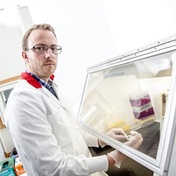”Instead of 99.9 percent identical, maybe we're only 99 percent alike," said J. Craig Venter, an author of the study and the person whose DNA was analysed for it.
Several previous studies have argued for lowering the 99.9 percent estimate. Venter says this new analysis "proves the point."
The new work, in the latest issue of PLoS Biology, marks the first time a scientific journal has presented the entire DNA makeup, or human genome, of an individual.
However, James D. Watson, co-discoverer of DNA's molecular structure, received his own personal DNA map from scientists a few months ago. And the genomes for both him and Venter are already posted on scientific web sites.
New paper suggests less ‘likeness’
Venter is president of the J. Craig Venter Institute in Rockville, Maryland, which does genetics research. He and scientists at his institute and elsewhere collaborated on the work that produced his genetic map.
The order of building blocks along a strand of DNA encodes genetic information, somewhat like the way a sequence of letters creates a sentence. Particular sequences form genes.
Landmark studies published in 2001 indicated that the DNA of any two people is about 99.9 percent alike. The new paper suggests estimates of 99.5 percent to just 99 percent, Venter said.
The Venter paper joins several others published over the past three to four years that indicate an estimate of around 99 percent, said Richard Gibbs, a DNA expert at the Baylor College of Medicine in Houston who did not participate in Venter's study.
New study seems more accurate
The studies produce the lower figure because they uncovered chunks of DNA that differ among people, whereas previous studies focused on differences in individual building blocks.
The 99 percent figure is close to what scientists have often estimated for the similarity between humans and chimps. But the human-chimp similarity drops to more like 95 percent when the more recently discovered kinds of DNA variation are considered, Venter said.
Gibbs called the Venter paper significant, along with a similar but not-yet-published analysis of Watson's DNA that he has worked on.
That is because the analyses show more differences than expected from the standard human DNA sequence published by the federal government, he said. (The federal sequence was based on a mix of DNA from different people.)
Individuals differ in DNA
That finding in turn is shedding light on how DNA varies among people, with implications for understanding the genetic underpinnings of disease, Gibbs said.
Although the new paper analyses just Venter's genetic material, it can make estimates about how individuals differ in their DNA.
Everybody inherits two sets of DNA, one from each parent. Venter's paper compared the DNA he inherited from his mother with the DNA from his father. – (Malcolm Ritter, Sapa)
Read more:
Junk DNA, evolutionary value
DNA clues to prostate cancer




 Publications
Publications
 Partners
Partners














